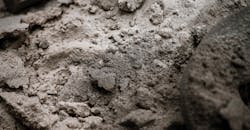For years, foundries been asking, “Where will all the sand go?” They have looked for ideas or innovations to deal with over 10 million tons of spent green sand from molding and coremaking operations annually — and particularly for sustainable treatment processes. Specifically, they have been looking for process solutions or options for beneficial reuse of all that sand.
Let’s focus on the green-sand dust collector fines, usually rich in active clay and carbon. The ideal treatment technique would:
1) reclaim active clay and lustrous carbon from the dust collector material; using
2) a water-based reclamation process to separate sand, clay, and carbon; with
3) no chemicals or unusual by-products; and 4) resulting in a clay slurry that has excellent performance characteristics.
The cost of disposal has been the driver for analyzing the savings potential of treatment/recovery processes, but the real spur to finding a new approach may be seen in the rapidly increasing logistics cost for inbound clay and carbon, and the safety restrictions that impose delays and surcharges on rail and trucking services. You may add to these factors the further difficulties resulting from weather patterns and the impact on infrastructure.
A realistic economic look at 20% clay and carbon reduction in consumption will save the average foundry at least $350 per ton, based on the amounts of clay and carbon consumed.
The proven technologies available today — which can be sized according to the foundry binder in use and can be fixed or mobile — offer a viable solution.
The advantage of hydrated clay / bond is that it has shown immediate improvements in molding-sand system performance, along with an added benefit from reduced benzene, toluene, and xylene (BTX) emissions.
The slurry is easily mulled or mixed-in during green-sand preparation, and the improved green-sand properties that result include:
• Increased green strength at equivalent MB clay levels;
• Reduced friability;
• Improved flowability and toughness;
• Increased wet-tensile strength; and,
• Increased green compressive and shear strengths.
Any such change in a foundry’s technologies and operating practices, as this will be, requires a commitment by the production team to work on application optimization, and to engineer the steps for integrating it into a green-sand system.
For foundries considering the potential for green-sand dust processing, following here is an example of a supplier-recommended analysis that would inform that consideration:
1. Mass-balance analysis, i.e., the consumption of green-sand molding additives. The mass balance is to be used as baseline data for measuring additive consumption with the introduction of slurry into the sand system, and is compared against the monthly volume of metal poured. The sand-to-metal ratio is monitored to understand how surface area affects the additive burn-out factor. Additions of new and core sand, and their diluting effect, are monitored and taken into consideration.
2. Molding sand trends. Routine sand samples should be taken to be tested and monitor the changes. The critical properties to be measured are moisture, compactability, green compression strength, wet tensile strength, dry compression, MB clay, and loss-on-ignition (LOI.)
3. Rejection of castings for molding sand-related defects. The percentage of rejected, inferior-quality products will be monitored before and after the introduction of slurry. The types of defects will be identified, and an effort will be made to categorize these in order to see where slurry is impacting the defect rate.
4. Emissions. Samples of the molding sand will be analyzed before and after the introduction of slurry so as to measure CO, alkanes, and BTX. Gas emissions of the sand should be monitored too, to see the before and after effects.
Rob Steele is the president of Foundry Advanced Clay Technologies. Contact him at [email protected], or learn more at www.foundryclay.com
